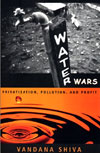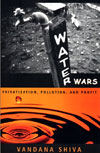I can see the source of the world’s water problems from my office window. It’s called the Fire Mountain Canal, and it winds its way past peach and apple orchards, through green horse pastures, and around the edge of the dry, juniper-covered mesa where I live. This fat, smooth snake of water seems like a generous thing; after all, it supports the work of local Colorado farmers, who stuff us with cherries, chilies, meat, and other goodies each year. But the canal cheats the river itself, sucking out so much water that the local swimming season ends in June. Thousands of other diversions, big and small, prey on other tributaries in our watershed, eventually shrinking the main stem of the Colorado River down to a ghost of itself.
Okay, so the Fire Mountain Canal and my neighborhood chili farmers aren’t causing all the world’s water problems. But the canal, like almost every other waterway in the western United States, is ruled by what you might call the I-was-here-first principle. This frontier-era rule reserves lots of water for early birds, less for latecomers, and none at all for the river itself. It also turns a river into a sort of used-car lot, allowing people to buy, sell, and steal as many shares of water as they possibly can.
In Water Wars: Privatization, Pollution, and Profit, Indian physicist and activist Vandana Shiva says the “cowboy economics” that govern the Fire Mountain Canal now govern the world’s entire supply of fresh water as well. The water-as-private-property model may have worked for the gold-rush mining camps where it developed, but Shiva says the global version is terrible news for the world’s rivers. It’s also leaving a lot of people with dangerously low water supplies.
“The current push to reintroduce and globalize the lawlessness of the frontier is a recipe for destroying our scarce water resources and for excluding the poor from their water share,” she writes. “Parading as anonymous markets, the rich and powerful use the state to appropriate water from nature and people.”
Shiva cites plenty of examples. In the United States, huge water projects like the Hoover Dam were built under pressure from private interests that wanted the water to build agricultural and urban empires in Southern California. Most big dams in the Third World have been built with financing from the World Bank, which usually requires privatization of water markets in exchange for development loans. Over the last 30 years, India alone has seen the construction of 1,554 large dams, many of them cooperative efforts of the Indian government, private industry, and international lending agencies. All of these large-scale projects, says Shiva, have disrupted traditional water-sharing systems, displaced millions of people, and helped to put water rights in the hands of the wealthy.
This pattern of privatization, combined with worsening pollution problems, is increasing the world’s thirst: Between 1990 and 2025, the number of people living in countries without enough fresh water is expected to rise from 131 million to 817 million. The staggering numbers, says Shiva, make scarce water much more than a health threat.
“Whether it is in Punjab or in Palestine, political violence often arises from conflicts over scarce but vital water resources,” says Shiva. “In some conflicts, the role of water is explicit, as is the case with Syria and Turkey, or with Egypt and Ethiopia. … [But] those who control power prefer to mask water wars as ethnic and religious conflicts.”
So what’s the solution to this escalating thirst and violence? Shiva points to several grassroots movements in India. The youth organization Tarun Bharat Sangh in Rajasthan has rebuilt traditional water-collection tanks and helped revive local decision-making about water systems; the citizens’ movement Mukti Sangarsh in Maharashtra has fought the production of water-intensive cash crops like sugarcane; the Swadhyaya movement of Gujarat has recharged 100,000 wells using volunteer community labor.
“The real solution to the water crisis lies in people’s energy, labor, time, care, and solidarity,” she writes. “The most effective alternative to water monopolies is water democracy. … The blueprints provided by people’s movements have shown the possibility of creating abundance out of scarcity.”
If there is a weakness to this book, it is that Shiva tries to cover the world’s water problems in just over 150 pages, so she forgoes detailed solutions and skims over many fascinating stories. The water conflict between Israel and its Arab neighbors, the recent Bolivian uprising against the privatization of a municipal water supply, and the multinational battle over the Nile get only a page or two each.
Yet in its few pages, Water Wars succeeds in making a very powerful and important argument for the democratic control of fresh water, one that makes me see even my neighborhood irrigation canal in a new light. Water is the basis of life, says Shiva, and it can never be replaced. How can we possibly put a price on such a thing?



